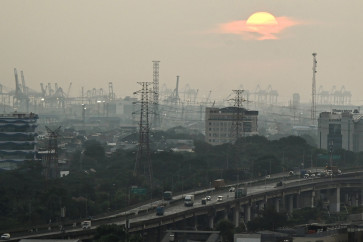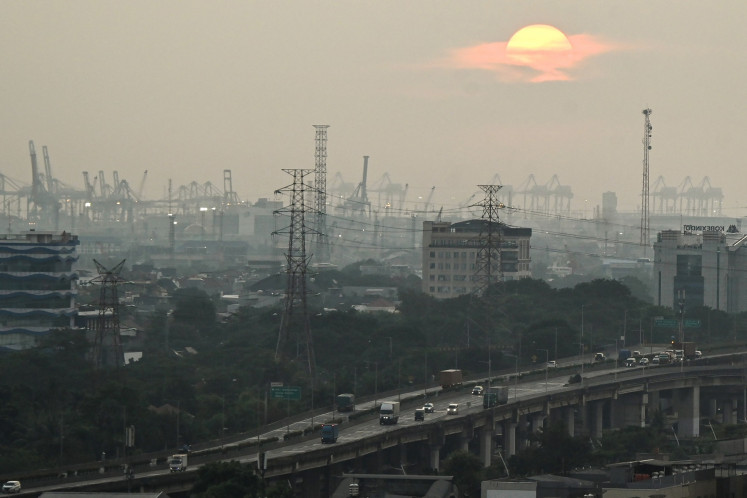Radar failure ‘horrifying’
Chilling new details have emerged following Sunday’s blackout at Soekarno-Hatta International Airport, with Coordinating Economic Minister Hatta Rajasa saying that at least two passenger aircraft were nearly involved in a mid-air collision following a glitch in the airport’s radar system
Change text size
Gift Premium Articles
to Anyone

C
hilling new details have emerged following Sunday’s blackout at Soekarno-Hatta International Airport, with Coordinating Economic Minister Hatta Rajasa saying that at least two passenger aircraft were nearly involved in a mid-air collision following a glitch in the airport’s radar system.
The incident involved two Lion Air planes, which were scheduled to land at the international airport but were then ordered to return to their origin airports because of a malfunction with air traffic control (ATC), Hatta told reporters at the State Palace.
“After the electricity outage disrupted the work of the airport’s air traffic management, ATC lost track of approaching aircraft [...] among them being the two planes involved in a ‘near-miss’ incident,” said Hatta, who served as transportation minister between 2004 and 2007.
Hatta declined to provide more details on the incident, or which flights had been involved. “During the blackout, almost all Lion flights bound for Soekarno-Hatta were asked to return to their airports of origin, only two were diverted to Semarang,” he said, referring to Ahmad Yani International Airport in the capital city of Central Java.
Hatta said he was deeply concerned about the blackout, which was a repeat of similar incidents in the past few years.
“Can you imagine dozens of planes losing guidance for 15 minutes? That’s an eternity in an airspace surrounding a busy airport,” he said.
Hatta warned that although a catastrophe had been averted and no huge financial losses were suffered, such an incident should never be allowed to reoccur “because such an incident is horrifying”.
Soekarno-Hatta, which is run by state-owned PT Angkasa Pura II, is still the country’s main international gate. Airports Council International named it the world’s 12th-busiest airport in 2011 based on the number of annual passengers.
Angkasa Pura II corporate secretary Trisno Heryadi said that Hatta had not used the term “near miss” properly.
“What I take away from Hatta’s statement is that he was trying to emphasize the importance of addressing the problems, because they pose a serious risk and endanger people’s lives. But I have not heard any reports from the ATC people about any near-miss incident,” he said.
Trisno maintained that in spite of the blackout, air traffic controllers were still able to perform their jobs properly.
“When the blackout occurred, the monitors were dead. But the controllers were still able to maintain traffic management by using radio communication,” Trisno added.
Under such circumstances, each pilot of an incoming flight was required to provide a report about the aircraft’s position, altitude, heading and speed using radio transmission.
Trisno also denied that pilots of some approaching aircraft had told ATC that their traffic collision avoidance systems (TCAS) sounded warnings.
A TCAS is an instrument that monitors the airspace around an aircraft and warns pilots of the presence of other aircraft that could present the threat of a mid-air collision.
Contacted separately, Lion Air general affairs director Edward Sirait said he had yet to receive reports about any of Lion’s planes being involved in a near-miss incident.
“No Lion Air pilot has filed a report about a near-miss event during the radar blackout yesterday. So, I can neither confirm nor deny his [Hatta’s] statement,” he said.
Transportation Ministry spokesman Bambang S. Ervan also said that he had not been informed about such an incident.
“By ‘near-miss’, the minister may have been referring to an event in which two airborne aircraft came closer than the minimum distance allowed. That very possibly happened during the blackout,” Bambang said.
Internationally, the vertical separation between two flying aircraft should be no less than 300 meters. If two aircraft are separated by less than the minimum vertical separation, their horizontal distance should be no less than 5 nautical miles or about 9 kilometers.
A statement released by Angkasa Pura II said the brief power outage had resulted in 64 flight delays.
Budi Hendro, the airport’s air traffic services acting general manager, said that at the time of the incident, not only had the electricity failed but the uninterrupted power supply (UPS) had also malfunctioned.
“The UPS system was burned out,” he said.









